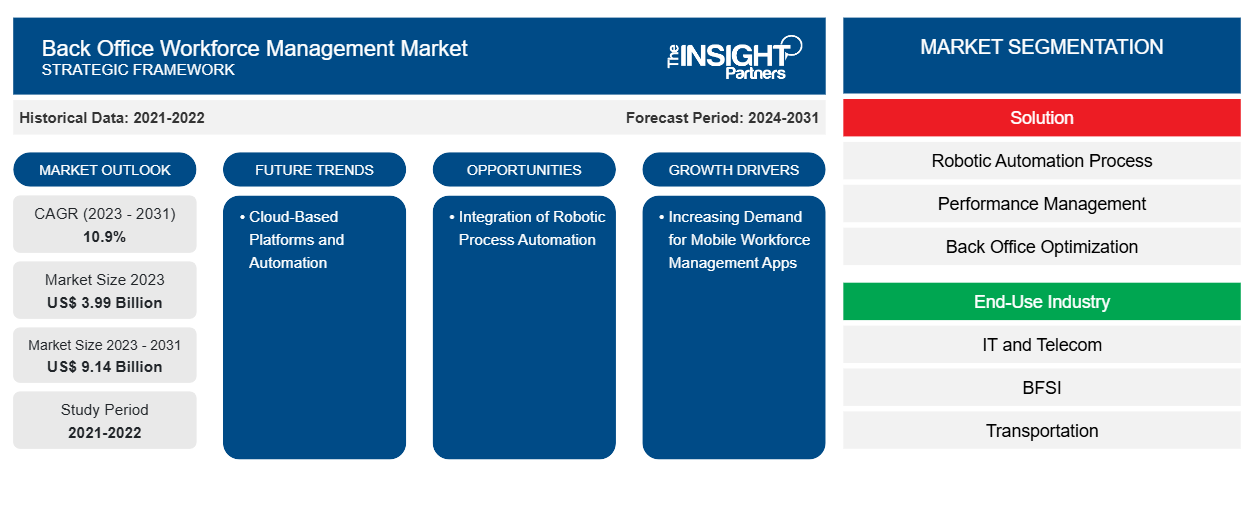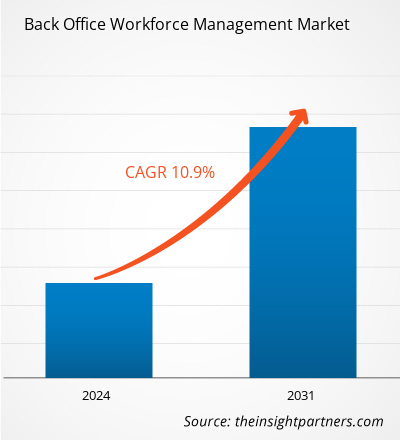The back office workforce management market size is projected to reach US$ 9.14 billion by 2031 from US$ 3.99 billion in 2023. The market is expected to register a CAGR of 10.9% during 2023–2031. Cloud-based platforms and automation are likely to remain a key trend in the market.
Back Office Workforce Management Market Analysis
The back office workforce management market is driven by the need for workforce optimization, increasing cloud deployment, and higher compliance with different regulatory mandates. More importantly, the pandemic has significantly impacted this market by rapidly accelerating the adoption of remote and flexible work arrangements and greatly increasing demand for solutions that allow remote work. Major market participants and the adoption of transparent, justified means of employee monitoring systems act as major growth drivers. Improved standards of workforce management with the integration of new technologies such as IoT and AI are also pumping up the market.
Back Office Workforce Management Market Overview
Back Office Workforce Management refers to the administration and coordination of internal business operations not directly associated with customers. It encompasses huge functionalities such as accounting, inventory management, supply-chain management, human resources, logistics, and IT services, among many more. The back office plays an essential role in supporting the front office team's objectives and goals by handling activities pertaining to administration, record maintenance, data management, and so forth. It may further involve effective management of resources, technology, and services to ensure proper flow of the organization's internal processes. The back office is important for workload optimization, customer and employee satisfaction, and, finally, driving improvements in operations.
Customize This Report To Suit Your Requirement
You will get customization on any report - free of charge - including parts of this report, or country-level analysis, Excel Data pack, as well as avail great offers and discounts for start-ups & universities
Back Office Workforce Management Market: Strategic Insights

-
Get Top Key Market Trends of this report.This FREE sample will include data analysis, ranging from market trends to estimates and forecasts.
Back Office Workforce Management Market Drivers and Opportunities
Increasing Demand for Mobile Workforce Management Apps
Companies are increasingly looking towards application-based solutions to manage the back-office workforce with the aim of creating intelligent work environments. Being apprehensive about absorbing the benefits of mobility will cost tons in the long run due to the inefficiency that may result. In this regard, a mobile application can be used to provide a single platform at the center of creating a consistent experience across the connected employee base. Location monitoring enables enterprises to deliver relevant content and real-time notifications across the workforce for the creation of timely and pertinent experiences that ensure efficiency, productivity, and employee engagement. Mobile applications make it easier to log official days of work and all other details manually into the data system. It acts like one place through which all the digital touchpoints involved in the management of a workforce can be seamlessly integrated. Consolidation of work-related assets into one app, on the other hand, enables an enterprise to manage the smooth working of employees inside or outside the workplace and also communicate and collaborate with the management teams and coworkers. The growing level of recognition regarding the advantages of mobile app-based solutions for workforce management creates opportunities for players in the back office workforce management market.
Integration of Robotic Process Automation
One of the major trends that the market is likely to witness is the incorporation of robotic process automation into back office workforce management solutions. RPA is defined as a mechanism that proposes to acquire a bigger number of operational duties by robots, which in turn increases efficiency, productivity, and employee engagement. The new wave of demand for automation of workforce responsibilities is an excellent opportunity for the players involved in this industry. It can be used to gear up its capabilities in catering to new businesses that look toward optimizing operational processes and employee performance.
Back Office Workforce Management Market Report Segmentation Analysis
Key segments that contributed to the derivation of the back office workforce management market analysis are solution and end-use industry.
- Based on solution, the market is bifurcated into robotic automation process, performance management, back office optimization, process analytics, and others. The performance management segment held a significant market share in 2023.
- Based on end-use industry, the market is segmented into IT and telecom, BFSI, transportation, retail and e-commerce, government, and others. The BFSI segment held a significant market share in 2023.
Back Office Workforce Management Market Share Analysis by Geography
The geographic scope of the back office workforce management market report is mainly divided into five regions: North America, Asia Pacific, Europe, Middle East & Africa, and South & Central America.
In North America, the US stands out as a crucial market, with a substantial number of Fortune 500 companies headquartered in the country, driving the demand for back office workforce management solutions. The adoption of cloud-based workforce management solutions is on the rise in response to the increasing prevalence of remote work arrangements, enabling organizations to effectively monitor the working hours and productivity of employees operating from diverse locations.
Back Office Workforce Management Market Regional Insights
The regional trends and factors influencing the Back Office Workforce Management Market throughout the forecast period have been thoroughly explained by the analysts at The Insight Partners. This section also discusses Back Office Workforce Management Market segments and geography across North America, Europe, Asia Pacific, Middle East and Africa, and South and Central America.
Back Office Workforce Management Market Report Scope
| Report Attribute | Details |
|---|---|
| Market size in 2023 | US$ 3.99 Billion |
| Market Size by 2031 | US$ 9.14 Billion |
| Global CAGR (2023 - 2031) | 10.9% |
| Historical Data | 2021-2022 |
| Forecast period | 2024-2031 |
| Segments Covered |
By Solution
|
| Regions and Countries Covered |
North America
|
| Market leaders and key company profiles |
|
Back Office Workforce Management Market Players Density: Understanding Its Impact on Business Dynamics
The Back Office Workforce Management Market is growing rapidly, driven by increasing end-user demand due to factors such as evolving consumer preferences, technological advancements, and greater awareness of the product's benefits. As demand rises, businesses are expanding their offerings, innovating to meet consumer needs, and capitalizing on emerging trends, which further fuels market growth.

- Get the Back Office Workforce Management Market top key players overview
Back Office Workforce Management Market News and Recent Developments
The back office workforce management market is evaluated by gathering qualitative and quantitative data post primary and secondary research, which includes important corporate publications, association data, and databases. A few of the developments in the back office workforce management market are listed below:
- Zapier, the workflow automation platform for small and midsized businesses, announced that it had acquired the team behind Vowel, an AI-powered video conferencing tool, for an undisclosed amount. Vowel's CEO, Andrew Berman, will become the new Director of AI at Zapier. Through this acquisition, the Vowel team will focus on enhancing Zapier's AI automation capabilities.
(Source: Inter Zapier Inc., Company Website, March 2024)
Back Office Workforce Management Market Report Coverage and Deliverables
The “Back Office Workforce Management Market Size and Forecast (2021–2031)” report provides a detailed analysis of the market covering below areas:
- Back office workforce management market size and forecast at global, regional, and country levels for all the key market segments covered under the scope
- Back office workforce management market trends, as well as market dynamics such as drivers, restraints, and key opportunities
- Detailed PEST/Porter’s Five Forces and SWOT analysis
- Back office workforce management market analysis covering key market trends, global and regional framework, major players, regulations, and recent market developments
- Industry landscape and competition analysis covering market concentration, heat map analysis, prominent players, and recent developments in the back office workforce management market
- Detailed company profiles
Frequently Asked Questions
What is the expected CAGR of the back office workforce management market?
What would be the estimated value of the back office workforce management market by 2031?
Which are the leading players operating in the back office workforce management market?
What are the future trends in the back office workforce management market?
What are the driving factors impacting the back office workforce management market?
- Historical Analysis (2 Years), Base Year, Forecast (7 Years) with CAGR
- PEST and SWOT Analysis
- Market Size Value / Volume - Global, Regional, Country
- Industry and Competitive Landscape
- Excel Dataset
Recent Reports
Related Reports
Testimonials
Reason to Buy
- Informed Decision-Making
- Understanding Market Dynamics
- Competitive Analysis
- Identifying Emerging Markets
- Customer Insights
- Market Forecasts
- Risk Mitigation
- Boosting Operational Efficiency
- Strategic Planning
- Investment Justification
- Tracking Industry Innovations
- Aligning with Regulatory Trends





















 Get Free Sample For
Get Free Sample For